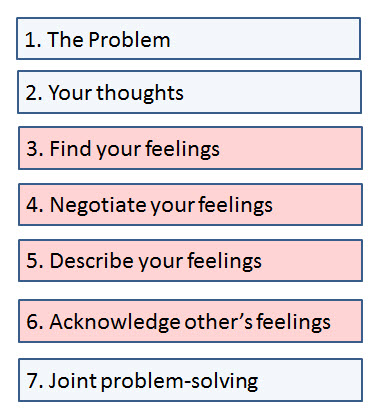“Never mind all that feelings stuff, let’s just do it”. Just do it.
Just do the work. If only life were so simple. In the workplace, jointly solving problems often involves difficult conversations, and conflicting views. Difficult conversations won’t go well unless feelings are surfaced. We have to have those conversations. Change happens, finding solutions to problems, through conversations.
Talking about our feelings is a challenge
In some workplaces that I’ve consulted to; e.g., construction, there is not much of a tradition of talking effectively about feelings. In other workplaces I’ve been involved with, and which at first glance I thought, “oh, these people will know how to express their feelings, when needed”, I’ve been proven wrong.
Wherever I turn, I see how difficult it is to effectively express our feelings; e.g., without judgement, attribution, blame. I personally, know it, too. I was not raised to express my feelings as a pathway to solving problems. I’ve had to learn how, and still learning. My journey.
“Have your feelings or they will have you.”
Sometimes feelings are difficult and troubling, yet you still have a job to do; a problem to solve. Being able to communicate effectively with the other person(s) – about your feelings and about the problem – is crucial to success. An algorithm is needed.
Ben’s “Expressing Feelings” Algorithm
This week I’m re-reading, Difficult Conversations: How to Discuss What Matters Most, by Harvard Negotiation Project alumni Douglas Stone, Bruce Patton and Sheila Heen. (Patton was co-author of Getting to Yes with Roger Fisher). I first read the book 15 years ago. It’s such a well thought out guide. Inspired, I came up with an algorithm for expressing feelings. Combining suggestions from Difficult Conversations, along with my own experiences, I formulated this basic algorithm to communicate the role of feelings, in the context of problem-solving.
Note: By definition, an “algorithm is a methodical set of steps that can be used to make calculations, resolve problems and reach decisions”.
- The problem. A neutral stating of the (mutual) problem.
- Your thoughts. Your thoughts, perceptions, on the problem; no doubt with a bit of naming and blaming thrown in. Conflict has a way of growing.
- Find your feelings. Feelings are more complex and nuanced than we imagine. What are you feeling: exasperation, regret, worry, inadequacy, emptiness, envy… Identify the different feelings you’re having. Put your feelings cards on your mind’s table.
- Negotiate your feelings. Before saying what you are feeling, negotiate with yourself. “Our feelings are based on perceptions, and our perceptions are negotiable”. What are your perceptions? Examine your own story. Explore assumptions about their intentions. Determine your contribution to the problem.
- Describe your feelings. Frame your feelings back into the problem, express the full spectrum of your feelings, and share your feelings (without judgement, attribution, blame…).
- Acknowledge others’ feelings. Your can’t leap directly into problem-solving without, first, each side having their feelings heard. Acknowledging feelings is crucial in any relationship, especially so in those often referred to as “intractable conflicts”.
- Joint problem-solving. Now, go do it. Kick butt!
Applying the algorithm – an example
Here’s a workplace example I’ve created, involving you and a project team. Jim is the team’s leader.
- The problem. Our project team is behind schedule.
- Your thoughts (internal). “Jim is too controlling. He’s not asking anyone else on the team for their input re: scheduling. We’re in silos mode.”
- Find your feelings (internal). “I’m hurt and frustrated about the lack of teamwork. Bottom line is, I’m depressed about where this project is headed.”
- Negotiate your feelings (internal). “We all gain through teamwork. Maybe Jim is over his head in the leadership role? On my side, why haven’t I approached him about my concerns?”
- Describe your feelings (to Jim). “When you don’t consult with me, I feel hurt and frustrated, and worried to no end, about our project. I want you to ask me for input. I have good ideas, too, and working together, I know that we can get this project back on track.”
- Acknowledge others’ feelings (to Jim). “Jim, I kind of assumed you were feeling that, and I’m glad you felt comfortable enough of me to share it. Thank you.”
- Joint problem-solving (with Jim). “Great, let’s brainstorm some ideas, together…”
A logical fallacy (or not)?
We think of feelings as a human property (and maybe a few animal species, too). Primed by Yuval Harari’s Homo Deus, here’s an alternative thought:
- Algorithms help people learn to express their feelings.
- Computers operate using algorithms.
- Computers can learn to express feelings.
What do you think?
What do you feel?


Speak Your Mind